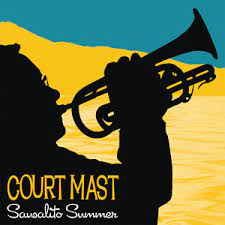
Daily Dose Of Jazz…
Court Mast was born Corky Miller on August 24, 1951 in Sunnyvale, California, where he took up the accordion and then trumpet in grade school. He went to Fremont High School, graduating in 1969. He traveled to Europe on tour with 120 high school and college musicians. Trumpet great Raphael Mendez was on board as guest artist, and Corky took six weeks of private lessons from the master. Returning to the Bay Area, he began performing in big bands around the South Bay and Peninsula and performed with the earliest version of the band that went on to fame as Tower of Power.
While taking performance and composition courses at De Anza College, Corky stayed active in a wide variety of bands, playing rock, jazz, Latin and Mexican music that kept this young working trumpeter onstage. By 1977 he moved to San Francisco, California where he led quartet and quintet jazz groups active on the North Beach music scene and in funky venues like the Hotel Utah.
Disillusioned with the direction that popular music, and jazz in particular, was moving in, in 1983 Miller stepped away from the music world. He became a surfer, changed his name to Court Mast, got into photography and became one of San Francisco’s leading commercial photographers. Then in the first decade of the new century his love of music returned and in 2008 he recorded his debut album Sausalito Summer
Composer and cornetist Court Mast, whose influences have been Henry Mancini, Chuck Mangione, Maurice Ravel, Duke Ellington, the Beatles, Steely Dan, Clifford Brown and Thad Jones, continues to compose and perform as well as maintain his photography.
More Posts: bandleader,cornet,history,instrumental,jazz,music
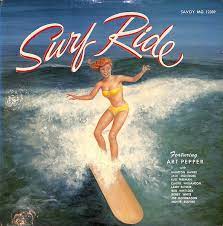
Requisites
SURF RIDE | ART PEPPER
Saxophonist Art Pepper made his debut recording session of Surf Ride in Los Angeles, California on March 4, 1952, when he recorded tracks 4-6 on the album. Subsequent recording sessions took place on March 29, 1953 when he recorded tracks 1-3 and then on August 25, 1954 recording tracks 7-12. The three sessions resulted in the completion of the twelve takes that ultimately made it to the album.
The album was produced by Ozzie Cadena and originally released as a 12 inch LP on the Savoy label in 1956. The liner notes were written by Yasukuni Terashima and the cover offers a clear though slightly too wholesome California motif to be considered for an addition to the cheesy Fifties Batchelor Collection of “girls on covers “, though the redhead in bikini helps.
TRACKLIST | 37:25 All compositions by Art Pepper except where noted.-
- Tickle Toe (Lester Young) – 2:55
- Chili Pepper – 3:00
- Susie the Poodle – 3:14
- Brown Gold – 2:26
- Holiday Flight – 3:1
- Surf Ride – 2:54
- Straight Life – 2:52
- Cinnamon – 3:11
- Thyme Time – 3:30
- The Way You Look Tonight (Dorothy Fields, Jerome Kern) – 3:48
- Nutmeg – 3:15
- Art’s Oregano – 3:08
- Art Pepper – alto saxophone
- Jack Montrose – tenor saxophone (tracks 7-12)
- Russ Freeman (tracks 1-3), Hampton Hawes (tracks 4-6), Claude Williamson (tracks 7-12) – piano
- Monty Budwig (tracks 7-12), Joe Mondragon (tracks 4-6), Bob Whitlock (tracks 1-3) – bass
- Larry Bunker (tracks 4-12), Bobby White (tracks 1-3) – drums
More Posts: choice,classic,collectible,collector,history,instrumental,jazz,music,saxophone
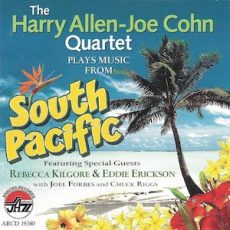
Daily Dose Of Jazz…
Charles “Chuck” Riggs was born on August 5, 1951 in Westerly, Rhode Island. Beginning in 1976 he played with Scott Hamilton and their association lasted well into the 1990s.
In the late 1970s and 1980s, he played with Bob Wilber, the World’s Greatest Jazz Band, Chris Flory, Benny Goodman, Kenny Davern, Dick Wellstood, Flip Phillips, Ruby Braff, and Jay McShann.
He was a member of the Concord Jazz All-Stars alongside Hamilton, Dave McKenna, and Gray Sargent in the early 1990s. Later in the decade he worked with Keith Ingham, Jon-Erik Kellso, and Ken Peplowski.
Riggs was featured on The Cotton Club, the soundtrack for the 1984 film of the same name.
Drummer Chuck Riggs continues to perform and record.
More Posts: drums,history,instrumental,jazz,music
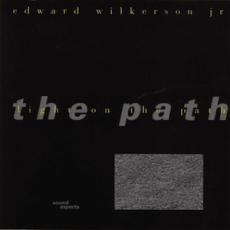
Daily Dose Of Jazz…
Edward L. Wilkerson Jr. was born in Terre Haute, Indiana on July 27, 1953. Over the course of his career he has associated himself with medium-to large-scale projects and has been a major presence in Chicago, Illinois’s Association for the Advancement of Creative Musicians (AACM), teaching and serving a term as president.
The AACM collective has been a nurturing force for Wilkerson and has informed much of his work. He was an original member of the Ethnic Heritage Ensemble formed by percussionist Kahil El’Zabar and remained with the group from 1976 until 1997. Though he recorded on three albums with the group he was becoming more involved in leading his own projects. His most ambitious project, Shadow Vignettes, was initiated in 1979 with 25 musicians and incorporated dance, poetry, and visual arts. The ensemble’s influences include the big band work of Muhal Richard Abrams, Duke Ellington, Count Basie and Sun Ra.
Wilkerson’s best-documented octet as a leader is 8 Bold Souls, a series of concerts that led Wilkerson to establish the group as a working band. They have released four albums, 8 Bold Souls, Sideshow, Ant Farm, and Last Option. Their music is influenced by the small groups of Duke Ellington and Jimmie Lunceford, but leaves room for adventurous experimentation.
In addition to his work with the preceding groups he has played with the AACM Big Band, Roscoe Mitchell, Douglas Ewart, the Temptations, Chico Freeman, the late Geri Allen, the Lyric Opera of Chicago, Muhal Richard Abrams, Aretha Franklin, and George Lewis.
Wilkerson has received grants from the Illinois Arts Council, the National Endowment for the Arts, Meet the Composer, and the Community Arts Assistance Program, and has been cited in numerous music polls.
Saxophonist, clarinetist, pianist, composer, arranger and educator Ed Wilkerson Jr., who has recorded 14 albums and two soundtracks, continues to teach composition at the AACM School of Music and explore the realms of jazz from his base in Chicago.
More Posts: arranger,bandleader,clarinet,composer,educator,history,instrumental,jazz,music,saxophone
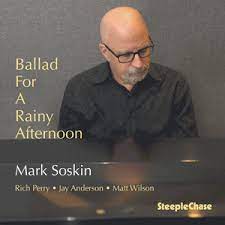
Daily Dose Of Jazz…
Mark Soskin was born on July 12, 1953 in Brooklyn, New York. Attending Colorado State University he pursued classical piano studies but his interests in jazz music grew and by 1973 he enrolled in Berklee College of Music in Boston, Massachiusetts. He studied composition and arranging. While there he began working professionally until moving to San Francisco, Califonia and eventually going on to work with some of the west coast’s finest players.
Shortly after arriving in San Francisco, he was introduced to Pete Escovedo and along with his daughter Sheila. E they toured and recorded as Azteca, a group in which Soskin’s keyboard, writing, and arranging talents were showcased. Eventually, the group, including trumpeter Tom Harrell, went on to record twice for Fantasy Records. Enlisted in Cobham’s band for two years produced two recordings for Columbia. Between tours for Cobham, Soskin did a tour and live recording for the CBS All Stars with Tom Scott, Alphonso Johnson and Steve Khan. At this time Soskin was an active session player at Fantasy.
Mark signed his first recording contract with Prestige titled Rhythm Vision with Benny Maupin and Harvey Mason among others. Introduced by Orrin Keepnews to Sonny Rollins, the two started a fruitful collaboration that lasted 14 years. By 1981 he was living in New York City as an active sideman and leader.
He has been written up in numerous music publications, including Ira Gitler and Leonard Feather’s Biographical Encyclopedia of Jazz and The Jazz Book by Joachim E. Berendt. Mark Soskin is featured in the film documenting latin jazz artists entitled Calle 54. Pianist Mark Soskin has recorded 10 albums as a leader, three as co-leader and continues to maintain a busy tour schedule as well as giving master classes, workshops, teaches privately and is on the faculty of The Manhattan School Of Music.




